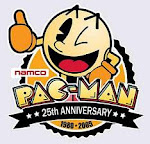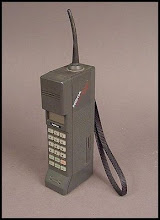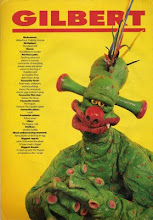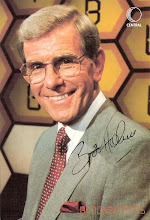August 1980 - the release of Ashes To Ashes, with its groundbreaking video, was a great moment for David Bowie - and propelled the Blitz Kids and others towards the pop scene to form the New Romantics, the first big 1980s music and fashion scene.
20th Century Words by John Ayto traces the term "New Romantic" to 1980. So, what was a New Romantic? Late 1980 saw the emergence of two acts - Adam And The Ants and Spandau Ballet - into the upper echelons of the pop charts. They gave us Ant Music and To Cut A Long Story Short, respectively, and although both songs were very different, the Ants and the Ballet blokes were both heavy on the face make-up and the dashing outfits of years long, long past.
And, suddenly, we were all talking of New Romantics.
1981 brought a flurry of them into our lives - including, of course, Duran Duran and Ultravox. Planet Earth, complete with video, was very typical of the scene - synths, futuristic setting, OTT dandy flounces, lashings of lippy, and bizarre hairdos. The movement crossed over to America and Kim Carnes sent us the divine Bette Davis Eyes.
TV Times, June 1981. How would you feel if your son looked like Adam Ant? If he'd lived where I lived, he'd probably have got seriously punched. But although nobody I knew was brave enough to adopt the image, Adam And The Ants were immensely popular with us lads.
So, the first big new pop sensation of the fledgling 1980s. How did it all begin?
Well, that's not quite what it seems! Read up on it elsewhere and you'll find that it all seems to have originated from a club called The Blitz Club in London, whose patrons paid homage to David Bowie - apparently dubbing themselves "Blitz Kids". Or was it somewhere called Billy's? Or both? Or...
Anyway, it was a dressy night club scene - or a couple of dressy night club scenes - where men wore make up and/or flamboyant outfits
The UK press created the "New Romantics" tag when Adam and the Ants and Spandau Ballet first hit the pop charts in late 1980.
David Bowie, of course, had been exciting the pop scene since 1969, and was very heavy on image. Was he Ziggy Stardust? A Thin White Duke (goodness, I thought that particular image was bloody boring and so retro!), but whatever he was he attracted dedicated followers in droves and his music brought flashes of sheer brilliance.
In 1980, David had another one of those flashes - with his Scary Monsters (and Super Creeps) album, and a single which would be included on this album, released in August 1980, although not officially classed as a New Romantic song, was what kick-started the scene. That song was, of course, Ashes To Ashes.
The video (or "promo" as we referred to them back then) was striking and hugely expensive, and featured Steve Strange, who wowed the pop charts in 1981 and 1982 with Visage hits like Fade To Grey and Mind Of A Toy.
But not all of those considered New Romantics in the early 1980s were part of The Blitz Club scene - Adam And The Ants for instance.
And I can certainly state that I'd never heard of the Blitz and what attracted me to the New Romantic style was that I had simply had enough of the gobbiness and run-down seediness that had dominated the previous decade.
Several years before the New Romantics, as I lurched into my teens, I was yearning for something a bit more flash, a bit more stylish. I was depressed with the thick layer of mould up my bedroom wall, my threadbare "make do and mend", often hand-me-down clothes.
I craved for glamour and excitement. I'm sure I was not alone! There was simply something in the air - many of us wanted a change.
After the likes of Slade shouting their mouths off - as tacky as you please, the sleaziness of the Disco scene and the hopelessness (and, of course big gobbedness) of Punk, plus the oh-so-unoriginal 1970s revivals of 1950s style, 1960s mods and rockers (no thank you, Paul Weller!), plus the '60s ska scene and rockabilly, I was hungry to dress up, desperately hoping that the 1980s would be different.
And they were.
And probably the first manifestation of that was the emergence of the New Romantics in late 1980.
The wonderful Roxy Music, still going strong in the early 1980s, are considered to be an influence on the New Romantics, and I'm sure the group was, but the New Romantics, despite their precursors, were still startling and fresh at the time.
Boy George, of course, was part of the Blitz Club scene, he worked as a cloakroom attendant there, and he was an early New Romantic for sure - but by the time he made his chart debut in 1982, the New Romantic thing, which had burned fiercely from late 1980 and throughout 1981, had fizzled as far as we the public were concerned. So, The Boy was, at the time, greeted as a stand alone newcomer, a unique individual, loved or loathed. Similarly, A Flock Of Seagulls, who had chart success in late 1982 with Wishing, whilst looking very New Romantic indeed, were not, at the time (as far as I remember!) labelled as such.

Let's hear it for the boy - Boy George, of course - before fame, pictured in the Daily Mirror in April 1981. Although an original New Romantic mover, shaker and trendsetter, by the time he arrived in the pop charts in 1982, the New Romantic scene was just about dead and buried. So, he was regarded simply as Boy George. And his own very personal sense of style inspired admiration, clones, and some homophobia. Soon-to-find-fame George (as seen in the newspaper picture), then simply referred to as George O'Dowd, 19, was wearing Chinese slippers (£3.99), old school trousers he'd
tapered himself, and leg warmers. A 1920s dress (20p, Oxfam) was draped
around his waist. The tassle belts, the long scarf, and Oxfam beads
around his neck, cost him a few pence, the crimplene blouse came from
his mum and the wooden cross from a friend. A black felt hat and
assorted earrings completed his outfit.
Adam and the Ants.. well, Adam
- AKA Stuart Goddard - has stated that his early '80s pop venture was
not part of the New Romantic movement. I never knew at the time. Loved
the band and saw it as very much part of the New Romantic thing way back
then. Sorry, Adam! I still love you and the Ants - whatever you were!
Two groups which I was labelling "New Romantic" long after 1981 were Duran Duran and Spandau Ballet. They were always and forever "New Romantics" to me. I loved the way the Duranies dropped the frillies for those gorgeous brightly-coloured suits - and the 1982 Rio video marked a turning point in my own personal fashion statements.
A change of image for Duran Duran, seen here in 1981 and 1982. Loved the colourful suits with pushed up sleeves and large shoulders!
Even now, knocking on towards fifty, I still feel a stirring of youthful (if that's possible at my age!) excitement at the thought of the New Romantics and the blossoming synth pop scene of the early 1980s in general. Combined, these two factors were the first indication that 1980s music and fashion were going to be OK for me. And, as it turned out, brilliant!
 The Sun, November 18, 1988.
The Sun, November 18, 1988. The arrival of the mobile phone in the 1980s was a boon to yuppies.
The arrival of the mobile phone in the 1980s was a boon to yuppies.


























